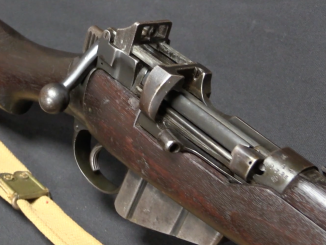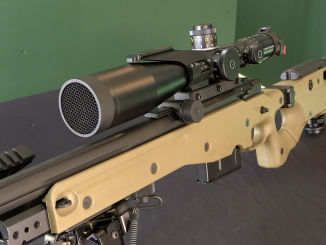One of the competitors against the Garand and Pedersen rifles in the 1929 and 1930 US Army trials was the White rifle. White actually submitted two rifles, but only this gas-operated design was actually tested – and it failed to make enough of an impression to move on for further testing. However, White’s gas system would come back 20 years later to be used in the M14 rifle.
Related Articles

Bolt Action Rifles
The Best SMLE: The No1 MkV Trials Rifle
After World War One, the British looked at how to apply the lessons of the war to development of a new infantry rifle. Even before the war, a decision had been made to move to […]

Manuals
EM-2 Rifle Manual
I recently got an email from a reader who had scanned the EM-2 manual section from the back of Thomas Dugelby’s EM2 Concept and Design and sent it to me. I thanked him (although I […]

Bolt Action Rifles
Arctic Warfare Magnum: Accuracy International L115A3
In 2007, the British Army placed an order for 582 AI Arctic Warfare Super Magnum rifles chambered for the .338 Laua Magnum cartridge, formally adopting the model as the L115A3 sniper rifle. This followed special […]

Excellent presentation (as always) Ian. Thank you!
Fascinating firearm.
On the charging handle, does it slide back on firing
and if so, would that cut into ones trigger hand’s thumb?
Is ammunition available for it?
Noticed that it does not have any identification stamping on it.
Regards
Pat
“ammunition”
You can buy .276 Pedersen here:
http://www.ammo-one.com/276PEDERSEN.html
So far I know it was produced only in 1920s-1930s, only by Frankford Arsenal.
http://milpas.cc/rifles/ZFiles/Misc/276%20Pedersen/the%20276%20Pedersen.html
states that .276 Pedersen case can be crafted from 6.5×54 [Mannlicher-Schönauer] case
That vertical falling lock operation is unique and very logical. It permits straight motion of single piece breech which may be reason for its compactness. Same apparently applies for gas system. Gun is shaped a bit weird, but it may be argued that it enhanced grip.
As usual on this web, an excellent presentation.
Ian:
An interesting presentation on the White rifle. However you misspoke. That was the stacking swivel near the muzzle not the forward sling swivel. My current unfinished project rifle is more or less an AR10 with an M14 gas system rotated 180 degrees. Thus the thrust from the gas piston goes straight back to the bolt carrier without the dogleg on the M1 or M14!
Sincerely,
Kerwin
Sounds like an interesting project. I hope you’ll be posting a report and pics on it.
Must admit to doing a bit of a double-take at the headline, since “white gas” was the name for unleaded gasoline back when the stuff at the station was leaded and you bought white gas at the hobby store for model airplanes. Had this image of a rifle cycled by a .049 cid engine…..
Timing is everything. It’s an impressive design that might have been very successful. Interesting to consider the possibilities if both the US and Britain adopted a common rifle and common caliber in the early ’30’s.
Weapons development history question –
Given the sensible advantages of an en-bloc clip, why did the world go to box magazines?
(I guess an en-block for 30 rounds would be impractical?)
Changes in manufacturing capabilities and weapon design requirements.
Box mags got way cheaper and more reliable during and after WW2 than they were in the 20’s and 30’s.
10 rds is about the max size for an enbloc, which is fine if you are designing a rifle to fire a big full sized round from mostly static positions. Its a really small number of bullets to have when used with any of the post WW2 fire and maneuver infantry tactics.
There is a story of some sailors who had landed at Gitmo and needed to re-qualify on their M1’s. Some marines were hanging around the range. This was just after the marines (but not yet the navy) had gone to the M-14. A young marine runs over and says “Sarge, look at that! He took the clip out of his belt and stuck it right on the rifle and started shooting. Why can’t we have a rifle like that?” “We did son, we did.”
If you think en-block clips are slick, you should try the M1941, Johnson, automatic rifle. It takes ’03 stripper clips or single cartridges. It can be topped off at any time with the remainder of the rounds in the weapon available for immediate use. The magazine does not drop out accidently and the feeding is a smooth as silk. But if you do manage to dent the rotary magazines outer shell, you need a new rifle fast.
I think one of those Springfield Socom’s might be ok with 8 rnd en blocs, but overall, banana 30rnd 7.62x39mm seems better for wider applications as would the weapon it feeds.
J C White/ Joseph C White of Boston Mass, bio on him? Found a lot of patents list for the man, Any successful firearm designs?
The patents I have by Joseph C. White indicate that he resided in Boston.
The Russian GSh-23-2 aircraft cannon has a locking arrangement similar to White’s rifle.
If anyone is interested, Roy Rayle’s book “Random Shots” goes into some technical detail about the white gas system in the M14 and M60 machine gun.
Hmm… Yes, if White had a few more years and perhaps a few more barrels, his design might have done better.
Given a choice in development, which would you “max out” and take into battle?
1. Pedersen
2. White’s prototypes
3. Rheinmetall-Heinemann rifle
4. Vollmer M35
5. RSC M1917
6. Johnson
7. Liu Rifle
8. Scotti Model X
9. Breda PG
10. Farquhar-Hill
11. Holek family (including the ZH-29)
12. DO WHATEVER!!!!!
This activity is voluntary. You are not required to participate if you do not wish to do so. Please keep any and all criticism of this post humane and free of foul language.
Thank you,
Cherndog
“DO WHATEVER!!!!!”
Рощепей self-loading rifle (see photo here: http://mil-history.livejournal.com/1010919.html )
I’ve always like the Johnson designs, but if I’m anticipating a hot scrum I’ll opt for the Johnson M1941 LMG, which is basically the rifle with a side-feeding box magazine and selective-fire. Lighter than a BAR, about as accurate as the rifle on single-fire, and with a quick-change barrel inherited from the rifle.
Incidentally, the Para-Marines in the Solomons really liked the Johnson rifle and LMG, as did Merrill’s Marauders in the CBI. The reason was that by removing the barrel, they could carry either one in a drop carrier attached to a parachute harness. As Edwin Tunis said of the later M1A1 folding-stock carbine, this allowed them to land shooting, instead of waiting for a rifle to come down on the next elevator.
cheers
eon
It is interesting that there are 4 or 6 locking lugs to limit the amount of vertical travel that the locking block must go through. The rectangular block behind the locking block that pops up when the gun goes into battery seems to be a firing pin block to prevent out of battery fire.
This is a striker fired rifle and the block seeming like a passive safety for battery off discharge, looks like a ejecting preventer for the striker front tip.
It is a striker, I apologize. Thanks for the patent number.
Related patent no: 1907163. RIA’s demonstration, 1907164 should be belonged to another model.
According the related patent description, this is a very expensive to make rifle with double action bars to activate the verticaly moving locking block through engaged cams and has a gas feed mechanism working only with pre-arranged volume of gas via slow accelarating way to prevent action issues riseable of sudden gas piston impact. Cocking is performed via a sliding bar at the right and its rearward exertion first engages a lug into the action bar and then forces the same backward. Recoiling breechblolt does not carry the cocking bar during firing. The rifle is striker fired and its firing tip is below its longitidunal axis.
The gas system as described sounds similar to that of the M60, but of course would come under much less strain in a rifle than a GPMG. I agree that if the charging handle were to come popping back over the grip each time it was fired, that would be distracting if not dangerous. It looks like a handy little piece though, and it’s a shame that it never progressed.
The White looks like a mass produced rifle. Usually prototypes look a little more rough. It looks really well made.
Would this require, waxed .276 or not? Primary extraction lark “some folk mentioned the term, once” I think, this opens quicker than an M14… Don’t know, I just think it might, given observing the mechanism by when operated by hand. I’ve had a few drinks mind… I don’t think the military at the time liked hard waxed rounds- For better or for worse.